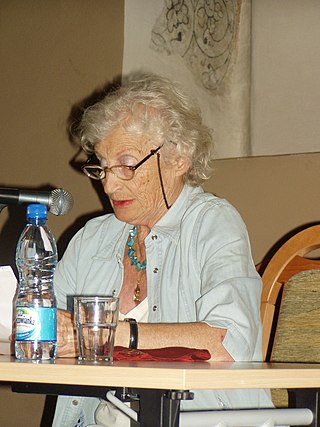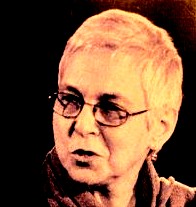
The General Government, formally the General Governorate for the Occupied Polish Region, was a German zone of occupation established after the invasion of Poland by Nazi Germany, Slovakia and the Soviet Union in 1939 at the onset of World War II. The newly occupied Second Polish Republic was split into three zones: the General Government in its centre, Polish areas annexed by Nazi Germany in the west, and Polish areas annexed by the Soviet Union in the east. The territory was expanded substantially in 1941, after the German Invasion of the Soviet Union, to include the new District of Galicia. The area of the Generalgouvernement roughly corresponded with the Austrian part of the Polish–Lithuanian Commonwealth after the Third Partition of Poland in 1795.

The ghetto uprisings during World War II were a series of armed revolts against the regime of Nazi Germany between 1941 and 1943 in the newly established Jewish ghettos across Nazi-occupied Europe. Following the German and Soviet invasion of Poland in September 1939, Polish Jews were targeted from the outset. Within months inside occupied Poland, the Germans created hundreds of ghettos in which they forced the Jews to live. The new ghettos were part of the German official policy of removing Jews from public life with the aim of economic exploitation. The combination of excess numbers of inmates, unsanitary conditions and lack of food resulted in a high death rate among them. In most cities the Jewish underground resistance movements developed almost instantly, although ghettoization had severely limited their access to resources.
Jewish studies is an academic discipline centered on the study of Jews and Judaism. Jewish studies is interdisciplinary and combines aspects of history, Middle Eastern studies, Asian studies, Oriental studies, religious studies, archeology, sociology, languages, political science, area studies, women's studies, and ethnic studies. Jewish studies as a distinct field is mainly present at colleges and universities in North America.

The Łódź Ghetto or Litzmannstadt Ghetto was a Nazi ghetto established by the German authorities for Polish Jews and Roma following the Invasion of Poland. It was the second-largest ghetto in all of German-occupied Europe after the Warsaw Ghetto. Situated in the city of Łódź, and originally intended as a preliminary step upon a more extensive plan of creating the Judenfrei province of Warthegau, the ghetto was transformed into a major industrial centre, manufacturing war supplies for Nazi Germany and especially for the Wehrmacht. The number of people incarcerated in it was increased further by the Jews deported from Nazi-controlled territories.

The Kraków Ghetto was one of five major metropolitan Nazi ghettos created by Germany in the new General Government territory during the German occupation of Poland in World War II. It was established for the purpose of exploitation, terror, and persecution of local Polish Jews. The ghetto was later used as a staging area for separating the "able workers" from those to be deported to extermination camps in Operation Reinhard. The ghetto was liquidated between June 1942 and March 1943, with most of its inhabitants deported to the Belzec extermination camp as well as to Płaszów slave-labor camp, and Auschwitz concentration camp, 60 kilometres (37 mi) rail distance.
The Holocaust has been a prominent subject of art and literature throughout the second half of the twentieth century. There is a wide range of ways–including dance, film, literature, music, and television–in which the Holocaust has been represented in the arts and popular culture.

Beginning with the invasion of Poland during World War II, the Nazi regime set up ghettos across German-occupied Eastern Europe in order to segregate and confine Jews, and sometimes Romani people, into small sections of towns and cities furthering their exploitation. In German documents, and signage at ghetto entrances, the Nazis usually referred to them as Jüdischer Wohnbezirk or Wohngebiet der Juden, both of which translate as the Jewish Quarter. There were several distinct types including open ghettos, closed ghettos, work, transit, and destruction ghettos, as defined by the Holocaust historians. In a number of cases, they were the place of Jewish underground resistance against the German occupation, known collectively as the ghetto uprisings.

Miriam Akavia also Matylda Weinfeld was a Polish-born Israeli writer and translator, a Holocaust survivor, and the president of the Platform for Jewish-Polish Dialogue.

Henryk Ross was a Polish Jewish photographer who was employed by the Department of Statistics for the Jewish Council within the Łódź Ghetto during the Holocaust in occupied Poland.

In the early modern era, European Jews were confined to ghettos and placed under strict regulations as well as restrictions in many European cities. The character of ghettos fluctuated over the centuries. In some cases, they comprised a Jewish quarter, the area of a city traditionally inhabited by Jews. In many instances, ghettos were places of terrible poverty and during periods of population growth, ghettos had narrow streets and small, crowded houses. Residents had their own justice system. Around the ghetto stood walls that, during pogroms, were closed from inside to protect the community, but from the outside during Christmas, Pesach, and Easter Week to prevent the Jews from leaving at those times.

Mordka Mendel Grossman was born on 27 June 1913 in Gorzkowice, Piotrków Governorate, Russian Empire. He died on 30 April 1945, during the death marches. He was a photographer and worker in the Statistical Department of the Litzmannstadt Ghetto.
Barbara Kirshenblatt-Gimblett is a scholar of Performance and Jewish Studies and a museum professional. Professor Emerita of Performance Studies at New York University, she is best known for her interdisciplinary contributions to Jewish studies and to the theory and history of museums, tourism, and heritage. She is currently the Ronald S. Lauder Chief Curator of the Core Exhibition and Advisor to the Director at POLIN Museum of the History of Polish Jews in Warsaw.
Sara Zyskind, alsoSara Plager-Zyskind, was a prominent Polish–Israeli writer on the Holocaust. She was a survivor of the Łódź Ghetto, and of the Auschwitz, the Mittelsteine concentration camp, and the Grafenort Nazi concentration camps. Her style as a writer on the Holocaust has been praised for its effective literary technique that allows the reader to identify with the reality of the period. Her writings constitute valuable primary sources in Holocaust historiography.
Of the six million Jews killed during the Holocaust, two million were women. Between 1941 and 1945, Jewish women were imprisoned in Nazi concentration camps or hiding to avoid capture by the Nazis under Adolf Hitler's regime in Germany. They were also sexually harassed, raped, verbally abused, beaten, and used for Nazi human experimentation. Jewish women had a sizable and distinct role in the resistance and partisan groups.

Photography of the Holocaust is a topic of interest to scholars of the Holocaust. Such studies are often situated in the academic fields related to visual culture and visual sociology studies. Photographs created during the Holocaust also raise questions in terms of ethics related to their creation and later reuse.

Joan Ringelheim was the Research Director of the Permanent Exhibition, Director of Education and Director of Oral History at the United States Holocaust Memorial Museum, where she oversaw its survivor testimony collection. She had worked on creating the museum's permanent exhibit. She would donate her collection which came, in part, from her organisation of the first conference about women, during the Holocaust.
Jacob Ari Labendz is a scholar of Jewish history and culture. His doctoral dissertation under the supervision of Hillel J. Kieval was titled "Jews and the State in Communist Central Europe: the Czech Lands, 1945–1989". From 2017 to 2022, he was employed as the director of the Center for Judaic and Holocaust Studies at Youngstown State University, also teaching history courses as an assistant professor. In 2021, his contract was not renewed, sparking protests from students, faculty, and other supporters, who collected 900 signatures on a petition against the cancelling of the contract.
Rachel Feldhay Brenner was a Polish-born college professor, writer, and scholar of Jewish literature. She was president of the Association for Israel Studies from 2007 to 2009.










